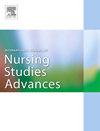Sick leave due to musculoskeletal disorders: A prospective cohort study
IF 3.1
Q1 NURSING
International Journal of Nursing Studies Advances
Pub Date : 2025-07-06
DOI:10.1016/j.ijnsa.2025.100376
引用次数: 0
Abstract
Background
In Norway, home care workers experience particularly high levels of medically-certified sick leave. A substantial percentage of sick leave is due to musculoskeletal disorders, which may be attributed to risk factors at work. Due to limited knowledge of the impact of working conditions on sick leave in this sector, an improved understanding of occupation-specific risk factors is needed.
Objective
To examine the impact of psychosocial and mechanical work factors on subsequent sick leave due to musculoskeletal disorders.
Design
Prospective cohort study.
Setting
A probability sample of 130 Norwegian municipalities and their respective home care services.
Participants
1819 home care workers.
Methods
Participants were surveyed on work environment factors and followed for 26 months between 2019 and 2021 using registry data on sick leave from the Norwegian Labour and Welfare Administration. Registry data comprised complete registrations of all medically-certified sick leave, including the relevant diagnostic codes of the International Classification of Primary Care system. Incidence risk ratios and 95 % confidence intervals were calculated using negative binomial regression with robust standard deviations. Population attributable risk and population preventable fractions were calculated to estimate the contribution of the significant work factors to sick leave in the sample.
Results
The following factors were associated with excessive risk of sick leave due to musculoskeletal disorders: Lifting or supporting the patient between bed and chair or wheelchair, heavy physical exertion without aids or assistance, heavy physical exertion despite aids or assistance, walking/standing, forward bending of the upper body, squatting/kneeling, and experiencing the work as physically demanding. Control over work pacing, fair leadership, empowering leadership, and support from immediate supervisor were associated with reduced risk of sick leave.
Conclusions
Preventive efforts to reduce sick leave due to musculoskeletal disorders among home care workers should adopt a multifactorial approach, including both psychosocial and mechanical work factors and the context in which they occur. There may be considerable potential for risk reduction by targeting awkward postures and heavy physical exertions, facilitating control over work pacing, and developing relationship-oriented leadership skills.
Registration
Clinical Trials - NCT03855163.
肌肉骨骼疾病的病假:一项前瞻性队列研究
背景在挪威,家庭护理工作者的医疗证明病假特别高。很大比例的病假是由于肌肉骨骼疾病,这可归因于工作中的风险因素。由于对该部门工作条件对病假影响的了解有限,因此需要更好地了解特定职业的风险因素。目的探讨心理社会因素和机械工作因素对肌肉骨骼疾病患者后续病假的影响。前瞻性队列研究。对130个挪威城市及其各自的家庭护理服务进行概率抽样。参与者:1819名家庭护工。方法对参与者进行工作环境因素调查,并在2019年至2021年期间使用挪威劳工和福利管理局的病假登记数据进行26个月的跟踪调查。登记处的数据包括所有经医生证明的病假的完整登记,包括国际初级保健分类系统的相关诊断代码。发生率风险比和95%置信区间采用具有稳健标准差的负二项回归计算。计算了人口归因风险和人口可预防分数,以估计样本中重要工作因素对病假的贡献。结果与肌肉骨骼疾病引起的病假风险过高相关的因素有:在床和椅子或轮椅之间搬运或支撑病人、在没有辅助或辅助的情况下进行大强度体力劳动、在没有辅助或辅助的情况下进行大强度体力劳动、行走/站立、上身前屈、蹲/跪、感觉工作对体力有要求。控制工作节奏、公平领导、授权领导和直接上司的支持与降低病假风险有关。结论:减少家庭护理人员因肌肉骨骼疾病而请病假的预防措施应采用多因素方法,包括社会心理和机械工作因素及其发生的环境。通过针对尴尬的姿势和繁重的体力劳动,促进对工作节奏的控制,以及发展以关系为导向的领导技能,可能会有相当大的风险降低的潜力。注册临床试验- NCT03855163。
本文章由计算机程序翻译,如有差异,请以英文原文为准。
求助全文
约1分钟内获得全文
求助全文
来源期刊

International Journal of Nursing Studies Advances
Nursing-General Nursing
CiteScore
5.80
自引率
0.00%
发文量
45
审稿时长
81 days
 求助内容:
求助内容: 应助结果提醒方式:
应助结果提醒方式:


